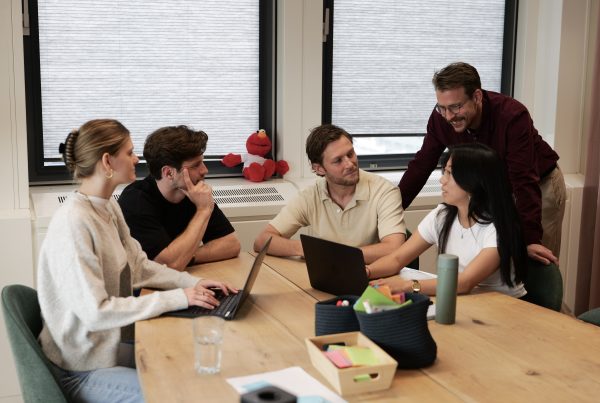Design sprints are a compact, intense method of quickly delivering organisational impact by pinpointing the areas where the most value can be made through data. By using design sprints to understand the key challenges within an organisation, we can develop a focus point for the upcoming period of a project.
At Amsterdam Data Collective (ADC), Kevin Hanemaaijer is the Head of Strategy and Innovation, which focuses on helping organisations unleash their data-driven potential. Together we discuss design sprints, including ADC’s unique approach, being inclusive, and principles for success.
How does ADC implement design sprints?
Although standard design sprints are four to five days and cover all five phases of design thinking, we prefer to follow two-day sprints that end in the third phase: ideating. This helps to determine which aspect of the project should be addressed first. We can then start the development process by testing and validating our key assumptions to deliver tangible results.
In a typical two-day design sprint at ADC, we spend the first day developing an understanding of the organisation and map their priorities, in addition to ideating potential solutions. It is important to start with a strong foundational understanding of the organisation, including its strengths and weaknesses, data maturity level, and opportunities and challenges involving data. Understanding is both the starting point and the foundation of the best end-to-end data science solutions.
The second day is spent ideating and sketching the solutions to make them tangible and creating a roadmap to determine the next steps. During ideation, we sketch the solutions because when you sketch something you have to simplify it and simple things work. It is important to get back to basics in order to know what is really necessary to create impact.
What does ADC hope to achieve through a design sprint?
We use design sprints to compress months of work into two days of focus and productivity that kickstart collaboration to create organisational impact. The use cases that are produced from the design sprint demonstrate both short-term and long-term value. As a result, when we start working on developing immediate value, we are also deep diving on how we can develop value over the long-term.
Typically, organisations first address the technical side of data science projects, often jumping straight into making a prototype. At ADC we prefer to take a different approach. From our perspective, we know what is technically feasible and achievable, but the complexity lies in the desirability and viability. Is this something we can truly make a difference with? Does the organisation really want to implement these changes? Is data science the best approach or are there other ways to address the challenge? These are questions we always address because becoming data-driven involves more than finding solutions that technically work. It is also necessary to focus on the greater impact to both the organisation and beyond.
How do you ensure that all voices are heard in a design sprint?
It can be a challenge to ensure that everyone’s voice is heard during both in-person and virtual design sprints. However, talking through a screen is definitely more challenging than being in a room, as we quickly discovered during COVID. This was a good opportunity for us to develop a standardised structure and set of core principles to follow during design sprints.
One of the most important core principles is ensuring that the team is multi-disciplinary. Before we start the design sprint, we select people from different areas of expertise who can deliver unique input on the challenge and ideas. For example, a team could consist of specialists in business development, information technology, and data science, in addition to a general manager. Having one specialist from each expertise not only creates diverse perspectives, but also allows everyone to give input, even those who are more introverted or less likely to speak up. Each person becomes the only point of reference on his or her specialised topic.
What are some other principles for a successful design sprint?
Following the set of core principles is essential for a successful design sprint. One of the core principles we follow is to timebox everything and enforce a hard stop at the end of the time limit. This ensures that we practice efficient time management and allow enough time to consider all aspects of the challenge at hand.
We also introduced ELMO (“Enough, Let’s Move On”). If a conversation begins to lose sight of what is relevant to the solution, anyone can shout out “ELMO”. We have started using this offline as well by bringing Elmo stuffed animals to our design sprints. Clients love them and repeatedly ask to keep their Elmo for internal meetings!
Let's shape the future
Do you want to know more about how we can help your organisation achieve its full data potential starting with our unique design sprint process? Get in touch with Kevin Hanemaaijer or check our contact page.







